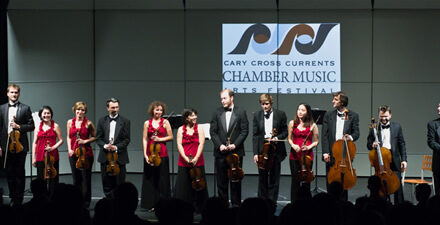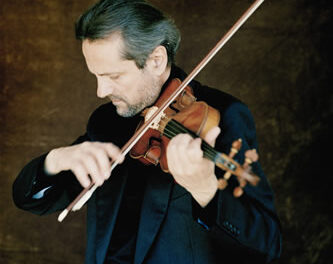There have been only three complete traversals of the complete Brandenburg Concertos by J.S. Bach in the Triangle area within the past thirty years and none that I am aware of in the Triad. In 1985, then Ciompi Quartet leader Bruce Berg was a member of the New York Chamber Soloists, which did all six for the Duke Artists Series. A certain sameness to the playing, on modern instruments, made for a long concert. Original instruments came up short when, in 1990, Ensemble Courant performed them in repeated Hill Hall concerts. Substitution of the second concerto’s trumpet by natural horn was a disaster when the player developed embouchure problems. The Mallarmé Chamber Players turned in a fairly satisfactory set in 1994. Anticipation was high for the July 16 performance of the six concertos with the faculty members of the Eastern Philharmonic Orchestra in Dana Auditorium. All were under the direction of noted harpsichordist Anthony Newman. Music lovers who began collecting recordings in the 1970s will remember his many Bach Lps, a few with psychedelic album covers. He still looks very much like he did in cover photos of the period.
Newman conducted all the concertos while seated with his back to the audience at a fine Richard Kingston harpsichord. An amplifier on a large speaker placed at the narrow end of the harpsichord helped subtly to boost its sound. The unidentified hornists played lustily in the mostly orchestral First Concerto, sometimes covering guest violino piccolo player Ruxandra Simionescu-Marquardt. In all the fast movements, Newman set brisk tempos that nonetheless allowed the music to breathe. There was a wonderful blending of the woodwinds throughout and a delicious dialog between the violino piccolo and the oboe in the slow second movement. The third movement had stirring trills from the robust horns.The program omitted the little sequence of dances after the third movement; this and the false visual cue of the soloist sitting down caused a large portion of the audience to applaud too early. Both cellist Christopher Hutton and Simionescu-Marquardt exhibited tasteful ornamentation, another characteristic of Newman’s whole performance. Newman’s own musicianship was more readily heard in the remaining five concertos. The Third featured fine blending of three violins, three violas, three cellos and bass. Longtime Associate Concertmaster Lisa Sutton was marvelous in her solos in the lively Fourth Concerto, which included flutes and seemed to burst with delight. Many commentators regard the Fifth Concerto as the first true harpsichord concerto. Newman hasn’t lost any of his keyboard mastery and turned in a magnificent performance of the great, extended keyboard cadenza. In the slow movement, there was a meltingly beautiful dialog between Assistant Concertmaster John Fadial and solo flutist Les Roettges. This concert was the only time that I have found a performance of the Sixth Concerto on modern instruments fully pleasing. It was intended for two violas, two violas da gamba, cello, bass and harpsichord, and almost all modern versions using only cellos seem far too bass-heavy or tubby. Through careful balancing and attention to dynamics, Newman managed to make this performance nearly ideal. Hannah Holman was the excellent first cellist. Careful attention to balance and chamber music style for brass made the popular Second Concerto a total success and brilliant finish for the series. Mark Niehaus carefully adjusted his trumpet playing in the high register so as not to cover his colleagues. He was also seated somewhat back, stage right. The other three soloists – violinist Randall Weiss, flutist Rebecca Troxler, and oboist Susan Eischeid – were arrayed across the front of the stage. All the concertos were played with attention to detail and an unusually lively sense of chamber music, enhanced by the use of different faculty members in each of the six pieces, with little duplication.
After a shaky start, the first of two Opera Gala concerts, featuring French and German highlights, came to a rousing conclusion July 18. With more than a dozen orchestral excerpts and arias to accompany, it was no wonder that the all-EMF-student-member Eastern Symphony Orchestra had some dragging brass and unsettled strings at the beginning of Wagner’s Prelude to Die Meistersinger von Nürnberg , but Conductor Scott Sandmeier reined them in by midway. They were much more confident, with soaring brass and full string choirs, in the Prelude to Act III of Lohengrin . Crisp Spanish rhythms and good solos from the harp, woodwinds and trumpet were plentiful in four orchestral excerpts from Bizet’s Carmen . Only harem dancers were missing from the steamy Bacchanale, from Saint-Saëns’s Samson and Delilah , that brought the audience to its feet at the end of the concert. The orchestra was well balanced and attentive to detail during its accompaniment of eight well-selected opera arias.
The first four arias were drawn from Mozart’s Die Zauberflöte . John Daniecki displayed a good firm lyric tenor voice during Tamino’s rhapsodizing over Pamina’s portrait but seemed a little tight, perhaps needing more warming up. With enough stage presence and personality for two people and with an extraordinarily expressive face, baritone Philip Lima was an audience favorite from his two impish Papageno excerpts onward. In addition to excellent diction and a warm, well-supported voice, he has a rare ability to project a character into a hall. The only caveat: he needed to sing a little louder, for his low notes don’t penetrate as well as the high ones. No flaws whatsoever were evident in the full, precise soprano of Yana Besyadynskaya. With a voice well-supported and superbly controlled throughout its range, she exhibited mastery of characterization and style in all of her selections. Her “Ach, ich fühl’s” was heartbreaking, fully conveying Pamina’s despair. She was delightfully flirtatious as Papagena in the humorous first duet with Lima as the enthusiastic Papageno. After intermission, Lima brought great subtlety to the Toreador Song from Bizet’s Carmen. This Escamillo was no loud braggart; Lima made a grand entrance, radiating the confidence to which Babe Ruth alluded, “It ain’t bragging if you can do it.” Safe in the knowledge that his reputation was understated, he casually flirted with the audience, which he held in the palm of his hand. I have never heard more musical value harvested from the aria. The great duet from Bizet’s The Pearl Fishers came next. Lima’s excellence as Zurga was never in doubt and Daniecki, as Nadir, came into his own as his voice really opened up and soared. The precise blending of the two in their ensembles was delicious. The Jewel Song from Gounod’s Faust , performed to perfection by Besyadynskaya, was breathtaking. Characterization, diction, phrasing, intonation – everything – seemed perfect. From the innocent Marguerite, she joined Lima for another musical gem from a very impure character, the courtesan Giulietta. The justly famous Barcarolle from Offenbach’s Tales of Hoffmann made for a perfect ending to the vocal portion of the First Opera Gala at the EMF.
Another full house was on hand for the second Opera Gala in Dana Auditorium, which featured the second EMF student orchestra, the Guilford Symphony Orchestra, under the alert direction of José-Luis Novo. Overall this group did very well in its five orchestral excerpts, although the violins were plagued with some intonation problems at the beginning. Barring this, their performance of Rossini’s Overture to L’Italiana in Algeri was spirited. The famous intermezzi from Leoncavallo’s I Pagliacci and Mascagni’s Cavalleria Rusticana had good, full string sound. Most successful were two Verdi pieces, the Overture to La Forza del Destino and the rousing Triumph March from Aïda, which ended the concert dramatically and brought a standing ovation. Novo made maximum use of spatial effects in the latter, positioning a trumpet in the alcoves above each stage exit and massing his on-stage extra brass on the back left.
Lima and Besyadynskaya had all the virtues described in the review of Gala I in spades. The only quibble I heard anyone voice about the winning baritone was that his voice didn’t penetrate or carry well. Other than this want of volume, he had the audience in the palm of his hand in every performance. He was the harried Barber, cataloging his clients in the famous “Largo al factotum” from Rossini’s The Barber of Seville . Turning many imaginary pages in the Spain section of Don Giovanni’s Book of Conquests, he brought many a chuckle to Leporello’s “Madamina, il catalogo è questo” from the Mozart opera.
Daniecki was more impressive in Italian repertory. In the last scene of Puccini’s Tosca, he fully conveyed Cavaradossi’s anguished remembrance of his time with Tosca in “E lucevan le stelle.” Besyadynskaya was rock-solid throughout her considerable range in “È strano!” and “Sempre libera” from Verdi’s La Traviata, with the tenor part sung off-stage. Both were in top form in the first meeting of the lovers in Puccini’s La Bohème. Daniecki communicated more of Rodolfo’s emotions than usual, and his beautifully-judged high notes were poignant. I hope that Triangle and Triad presenters were on hand to hear three very worthy candidates for future opera and concert performances. By their spontaneous and apt gestures, all the singers gave the impression that they were fully aware of what they were singing about in the original languages.
Greensboro Symphony subscribers in the full Dana Auditorium on July 20 had a chance to sample one of the finalists to succeed GSO Music Director Stuart Malina because the Eastern Philharmonic Orchestra’s guest conductor was Thomas Wilkins, one of the more prominent African-American conductors. With an elegant and restrained beat, Wilkins led a vital and memorable standard interpretation of Beethoven’s oft-played Symphony No. 7. Unlike many conductors, he had a full overview of the work and was able to keep the last movement from sounding anticlimactic. He and the faculty orchestra richly deserved their many curtain calls. This will join the very short list of great Beethoven performances in our region, along with one by William Henry Curry and the N.C. Symphony in Chapel Hill.
The concert opened with Michael Torke’s Javelin, commissioned for the 1996 Olympic Games in Atlanta. Swirling woodwinds and brass flourishes helped impart a sense of motion. The pleasing scoring ought to give this a chance for concert life beyond its original use, and many favorable comments were overheard at intermission. To conclude the program, Concertmaster Jeffrey Multer joined guest violist Paul Neubauer for a nearly ideal reading of Mozart’s Sinfonia concertante. Wilkins led the reduced orchestra with perfect balance and close attention to classical style. Bravo! I look forward to his November appearance with the GSO.












